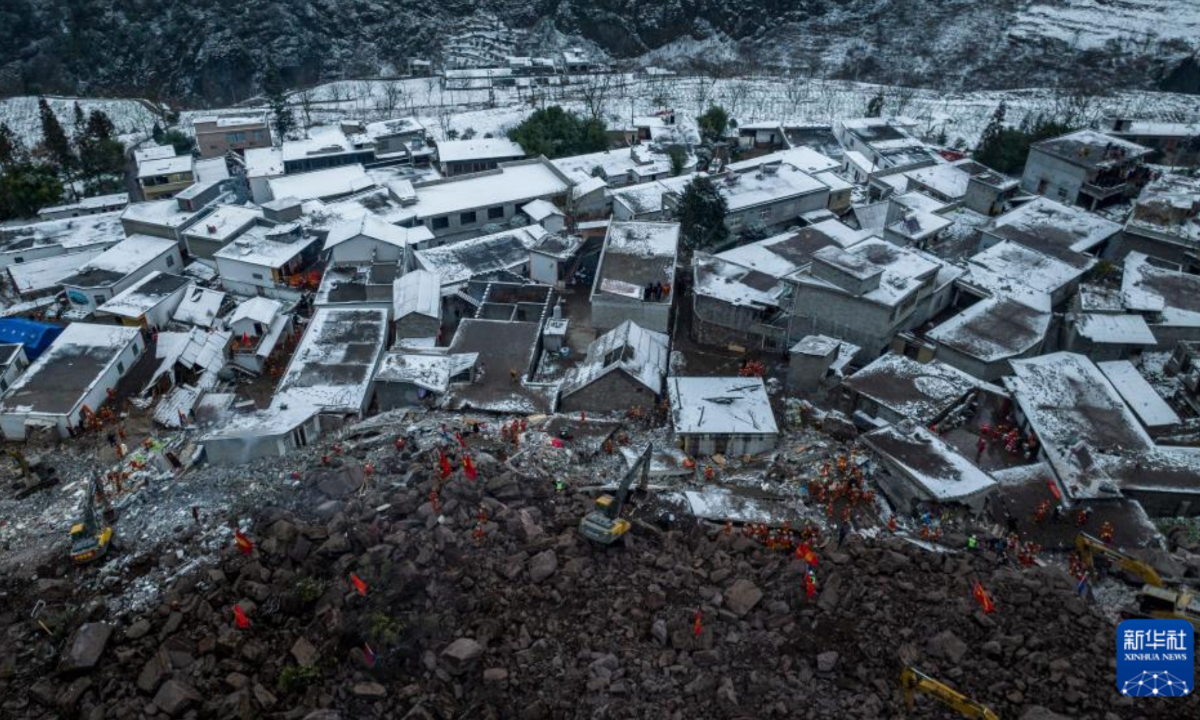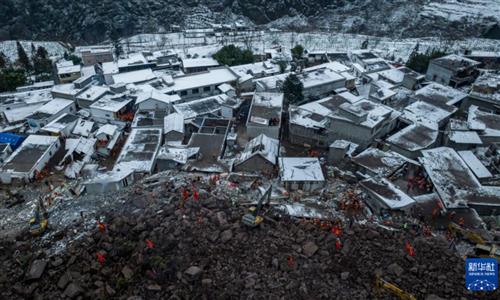
A view of the Zhenxiong county in Southwest China's Yunnan Province after the landslide on January 22, 2024. Photo: Xinhua
As of 17:40 on Tuesday, the landslide that took place on Monday morning in Zhenxiong county, Southwest China's Yunnan Province, has claimed 31 lives. The transportation to the affected areas remains unaffected, and electricity and communication services are operating normally, with rescue operations ongoing, media reported on Tuesday.
A total of 918 people have been relocated, with more than 1,000 rescue personnel deployed to carry out on-site rescue operations, as well as 81 search and rescue dogs to assist in the rescue efforts, according to the Xinhua News Agency.
Additionally, more than 150 excavators, loaders, and transport rescue vehicles were deployed for the rescue operation. Six professional search and rescue teams were stationed on-site, utilizing technologies such as radar life detectors, audio and video detectors, drones, and search dogs to conduct rescue operations in three different areas.
Besides, 16 ambulances and 113 medical rescue personnel were organized, with the allocation of 37,000 milliliters of blood for on-site treatment, China Central Television (CCTV) reported.
According to the CCTV News, various types of rescue supplies and daily necessities are guaranteed, including emergency allocation of tents, cotton coats, quilts, folding beds, mattresses, bedding, as well as mobile toilets and emergency lighting equipment.
According to the Beijing Youth Daily, a villager named Li Lie (pseudonym) said that the reason for such a significant loss of life was because the landslide occurred in the early morning when the villagers were still asleep. In addition, the drop in temperature, snowfall, and strong winds made the villagers unaware of the sound caused by the landslide, according to Li. "No one expected the collapse to happen so suddenly."
A fayou, a professor from the Faculty of Land Resources Engineering at Kunming University of Science and Technology, said that the county of Zhenxiong, where the landslide took place, is located in the northeast of Yunnan Province, with complex geographical environment leading to frequent disasters.
The night when the landslide occurred was both rainy and snowy, the expert said, noting that rainwater and melted snow water infiltrated into the pre-existing cracks, causing the rock and soil mass to soften. "When the cracks are filled with water, the water pressure increases, and combined with the steep terrain, the possibility of landslide increases," he said.
According to the on-site rescue personnel, the continuous snowfall and increasing number of fallen rocks on top of the collapsed houses have made the rescue operation much difficult.
The rescue workers told the Beijing Youth Daily that some houses were pushed several meters away by landslides, and the rocks on top of the houses were even three to four stories high. Meanwhile, it was still raining and snowing in the area, causing the roads to be slippery and icy.
As one of the first rescuers to arrive at the scene, Zhang Hua (pseudonym) and his team used excavators to slowly clear the fallen rocks from the edge of the collapse, and the depth and volume of the collapse made the rescue work challenging for Zhang. "The fallen rocks on top of the houses are very high, and all the trapped people are crushed underneath," Zhang said.
Another local resident said that there were still ongoing mountain collapses during the rescue process. The bulldozers would clear a little space, but it would quickly be buried by huge rocks, according to the Beijing Youth Daily.
Public information shows that the Zhenxiong county is located at the junction of Yunnan, Guizhou, and Sichuan provinces, with high mountains, steep slopes, and numerous valleys. Due to the influence of terrain, structure, rock types, and climate, geological disasters are prone to occur frequently in the local area.


